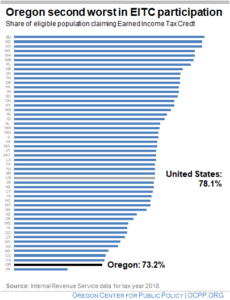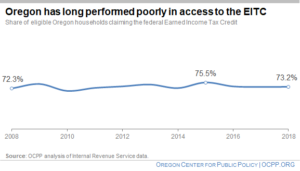[This issue brief was updated on April 4, 2022.]
Oregon families are among the least likely to benefit from the Earned Income Tax Credit (EITC) — a tax credit designed for families surviving on low wages. In 2018, only one state had worse EITC participation than Oregon. That year, more than one in four eligible Oregon households did not claim the credit, collectively missing out on $84 million in federal dollars.
Oregon needs to do more to reduce barriers to accessing the EITC — a credit shown to reduce poverty, improve health, and lead to better child outcomes.[1] Expanding free taxpayer assistance is an effective way Oregon can increase use of the EITC.
Oregon consistently has one of the nation’s lowest EITC participation rates
In 2018, the year with the most recent data on EITC participation, about 257,000 Oregon families claimed the tax credit.[2] This accounted for 73.2 percent of all Oregon working families that were eligible that year.
Oregon’s participation rate in 2018 was the second worst in the country, with 48 states plus the District of Columbia faring better. Only Alaska had an EITC usage rate worse than Oregon that year.

About 75,000 Oregon working families who were eligible for the EITC in 2018 did not access it. Together, these families missed out on an estimated $93 million —about $84 million federal dollars and $9 million state dollars — that year.[3]
Oregon’s poor performance in 2018 is consistent with its long-term pattern. Oregon’s EITC participation rate has narrowly fluctuated over the prior 10 years, never rising above 75.5 percent. Oregon’s rate of 73.2 percent in 2018 was virtually the same level as 10 years earlier.[4] During this period, Oregon never ranked better than 44th in the nation in terms of EITC participation. In some years — 2010, 2011, and 2012 — it tied for or ranked last in the nation.

Low EITC participation raises challenges for working families
The EITC is one of the most effective tools for helping working families meet their basic needs and improve their lives. In 2018, the average federal credit for households that claimed it was over $2,100. Of those that included children, the average was even higher — nearly $3,000.[5] The amounts provided by this refundable tax credit typically help families catch up on bills, purchase or repair a car, or invest in activities that enrich their children’s lives.[6]
The broad benefits of the EITC are well documented. Together with the federal Child Tax Credit, the federal EITC helped lift 129,000 Oregonians, including 65,000 children, out of poverty in the years after the Great Recession, from 2011 to 2013.[7] For children, the EITC has a lasting impact. A substantial body of research shows that tax credits such as the EITC improve child health, boost school performance, promote college enrollment, and increase earnings when children become adults.[8]
Barriers to the EITC make life unnecessarily difficult for children and families surviving on low wages.
Oregon’s economy suffers when few people use the EITC
Oregon’s low EITC participation not only undermines the well-being of families, it also represents a loss to the state. The EITC adds dollars to the Oregon economy by giving working people more money to spend. In 2018, the federal EITC brought $542 million in federal dollars to Oregon, dollars that flowed to every corner of the state. Nevertheless, Oregon left $84 million in federal dollars on the table, due to the fact that families eligible for the EITC did not claim the credit.
The economic loss to Oregon is even greater than that. Eligible families tend to spend their EITC refunds quickly at local businesses, as they make purchases to meet their basic needs. This spending generates more economic activity. Researchers estimate that each federal EITC dollar results in $1.40 to $1.58 in activity in the economy, as local businesses use EITC dollars to purchase goods and services and pay employees, and employees spend their earnings.[9]
Oregon should invest in free taxpayer assistance
Households eligible for the EITC face numerous obstacles to claiming the credit. These include complex tax forms and misunderstandings about eligibility and benefits.[10] While tax preparation assistance can improve use of the credit, the perceived and actual cost of getting assistance can be a hindrance.[11] Workers less likely to claim the credit are those who live in rural areas, are self-employed, have disabilities, are not proficient in English, or have no dependents.[12]
Oregon has taken modest steps in the past to increase use of the EITC, but the primary barriers remain. In 2017, the legislature began requiring employers to provide workers with written notice at tax time of the federal and state tax credits.[13] Nevertheless, Oregonians’ use of the EITC since then has not budged. The major barriers remain unaddressed — confusion about eligibility, the complexities of filing taxes, and, ultimately, the lack of appropriate and affordable help in filing a tax return.
To improve use of the credit, Oregon should invest in free, culturally-appropriate tax preparation services, accessible across the state. Privately-funded community-based assistance programs have served some Oregon communities in the past, but many have foundered for lack of on-going support.[14] Sustained public investment is vital to having a stable network of tax preparation services accessible to those who need assistance throughout the state.
Conclusion
Oregon’s pattern of low EITC participation continued in 2018, when it ranked second lowest in the nation. The low participation rate deprives households surviving on low wages the economic and social advantages an EITC refund can bring, while denying the state of the economic benefits of the infusion of federal dollars. To address barriers Oregonians face in claiming the credit, the state should invest in free taxpayer assistance.
[1] Chuck Marr, Chye-Ching Huang, Arloc Sherman, and Brandon Debot, The EITC and Child Tax Credit Promote Work, Reduce Poverty, and Support Children’s Development, Research Finds, Center on Budget and Policy Priorities, October 1, 2015.
[2] For this fact sheet, unless otherwise noted, all figures are OCPP analysis of Internal Revenue Service (IRS) data. The most recent data on state EITC participation is available here.
[3] Analysis of foregone federal EITC dollars by the Center on Budget and Policy Priorities (CBPP) made available to OCPP. The analysis is based on information from the IRS National Taxpayer Advocate and IRS EITC data. It considers that eligible people who don’t claim the credit are more likely to have no children claimed on their return and eligible for a smaller than typical credit. The analysis is based on unpublished IRS estimates of EITC claims by filing status, qualifying children, and average credit amount. Analysis of foregone state EITC dollars by OCPP using Oregon Department of Revenue data on EITC dollars by household size and IRS unpublished statistics.
[4]Oregon’s EITC participation rate in 2008 was 72.3 percent. Data obtained by OCPP from the IRS in 2019.
[5]Analysis by the Center on Budget and Policy Priorities (CBPP) made available to OCPP.
[6]Ruby Mendenhall et al., The Role of Earned Income Tax Credit in the Budgets of Low-Income Families, Social Service Review, February 2012.
[7]Oregon Fact Sheet: Tax Credits Promote Work and Fight Poverty, Center on Budget and Policy Priorities, September 2016.
[8]Ibid. Chuck Marr, Chye-Ching Huang, Arloc Sherman, and Brandon Debot, The EITC and Child Tax Credit Promote Work, Reduce Poverty, and Support Children’s Development, Research Finds, Center on Budget and Policy Priorities, October 1, 2015.
[9] OCPP analysis of findings: Antonio Avalos, Sean Alley, The Economic Impact of the Earned Income Tax Credit (EITC) in California, The California Journal of Politics & Policy, 2010, Vol. 2, Issue 1. Also, Targeted Messages Why me? EITC and Other Refundable Credits, IRS.
[10] Saurabh Bhargava, Dayanand Manoli, Psychological Frictions in and the Incomplete Take-up of Social Benefits: Evidence from an IRS Field Experiment, American Economic Review, 2015, 105(11): 3489-3529.
[11] Accessing on-line free tax preparation software can be difficult for people with low-incomes who are eligible. See H&R Block, Turbo Tax Accused of Obstructing Access to Free Tax Filing, NPR, May 7, 2019. In-person free tax preparation assistance is available in some communities in Oregon, but falls short of addressing the need. Riley Eldredge, Director of Cash Oregon/Metropolitan Family Services, estimates the free tax preparation infrastructure would need to increase by 7 times to meet the needed capacity. His statement made during Governor Kate Brown’s EITC Work Group, “Supporting Taxpayers” subcommittee, December 9, 2019.
[12]IRS, About EITC website. Also, Marsha Blumenthal, Participation and Compliance with the Earned Income Tax Credit, National Tax Journal, Vol. 58, N. 2 (June, 2005). Pp. 198-213.
[13] SB 398 (2017).
[14] Statements by Janet Byrd, Executive Director, Neighborhood Partnerships, made during Governor Kate Brown’s EITC Work Group, “Supporting Taxpayers” subcommittee, December 9, 2019, and OCPP’s communication with the Native American Youth and Family Center.





